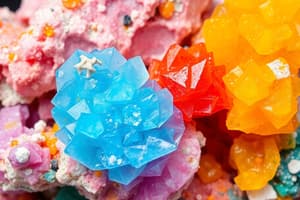Podcast
Questions and Answers
What is one of the main applications of silicate minerals?
What is one of the main applications of silicate minerals?
- Textile manufacturing
- Building materials (correct)
- Food preservation
- Fuel production
How do silicate minerals assist in the field of geochemistry?
How do silicate minerals assist in the field of geochemistry?
- Studying plant growth
- Used for weather forecasting
- To predict earthquakes
- To study geochemical cycles of elements (correct)
What role do silicate minerals play in environmental science?
What role do silicate minerals play in environmental science?
- Assessing ocean acidity levels
- Study of soil fertility and nutrient cycling (correct)
- Study of atmospheric composition
- Aid in interstellar exploration
Why are silicate minerals classified into four main categories?
Why are silicate minerals classified into four main categories?
Which field does NOT benefit significantly from the use of silicate minerals?
Which field does NOT benefit significantly from the use of silicate minerals?
How do silicate minerals contribute to the study of the Earth's mantle?
How do silicate minerals contribute to the study of the Earth's mantle?
Which type of silicate minerals have three directions of infinite polymerisation of tetrahedra?
Which type of silicate minerals have three directions of infinite polymerisation of tetrahedra?
Which category of silicate minerals is less common and has a more limited range of compositions?
Which category of silicate minerals is less common and has a more limited range of compositions?
In which type of silicate minerals do the silicate tetrahedra form flat sheets held together by hydrogen bonds?
In which type of silicate minerals do the silicate tetrahedra form flat sheets held together by hydrogen bonds?
Which silicate minerals exhibit a wide range of compositions extending from a single tetrahedron (TO 4) to a completely connected framework (TO 2)?
Which silicate minerals exhibit a wide range of compositions extending from a single tetrahedron (TO 4) to a completely connected framework (TO 2)?
What is the main characteristic that differentiates chain-ribbon silicates from cluster silicates?
What is the main characteristic that differentiates chain-ribbon silicates from cluster silicates?
Which type of silicate minerals has sheets of silicate tetrahedra linked together in a chain-like structure?
Which type of silicate minerals has sheets of silicate tetrahedra linked together in a chain-like structure?
Flashcards are hidden until you start studying
Study Notes
Silicate minerals are a diverse group of minerals that make up a significant portion of the Earth's crust. They are formed when silicon and oxygen combine in various structures, often with other elements such as aluminum, magnesium, and iron. Silicate minerals can be divided into four main categories based on their structure: cluster, chain-ribbon, sheet, and framework.
-
Cluster silicates (neso-, soro- and cyclosilicates) are those that do not have an infinitely extended spatial polymerisation of tetrahedra. These minerals are less common and have a more limited range of compositions.
-
Chain-ribbon silicates (inosilicates) have one direction of infinite polymerisation of tetrahedra. They form sheets of silicate tetrahedra that are linked together in a chain-like structure.
-
Sheet silicates (phyllosilicates) have two directions of infinite polymerisation of tetrahedra. They form flat sheets of silicate tetrahedra that are held together by hydrogen bonds.
-
Framework silicates (tectosilicates) have three directions of infinite polymerisation of tetrahedra. They form a three-dimensional framework of silicate tetrahedra that is held together by cations such as calcium, sodium, and potassium.
Silicate minerals exhibit a wide range of compositions, extending from a single tetrahedron (TO 4) to a completely connected framework (TO 2). The intermediate compositions overlap between the various major groups of connectivities. This hierarchy allows for the observation of how the chemical composition and structure of silicate minerals can be generated from n-connected plane nets and various oikodoméic operations (topological building operations).
Silicate minerals have a wide range of applications, including in construction materials, ceramics, and electronics. They are also used in the production of glass and in the manufacture of various chemicals. In geology, they play a crucial role in the formation of rocks and soils, and they are often used as indicators of the geological history of an area.
In the field of geochemistry, silicate minerals are used to study the geochemical cycles of elements such as magnesium, aluminum, and iron. They are also used in the study of the Earth's mantle and the formation of igneous rocks. In environmental science, silicate minerals are used in the study of soil fertility and the cycling of nutrients in the soil.
In conclusion, silicate minerals are a diverse and essential group of minerals that play a crucial role in the Earth's crust and have numerous applications in various fields. Their classification into four main categories based on their structure allows for a better understanding of their properties and behaviors.
Studying That Suits You
Use AI to generate personalized quizzes and flashcards to suit your learning preferences.




